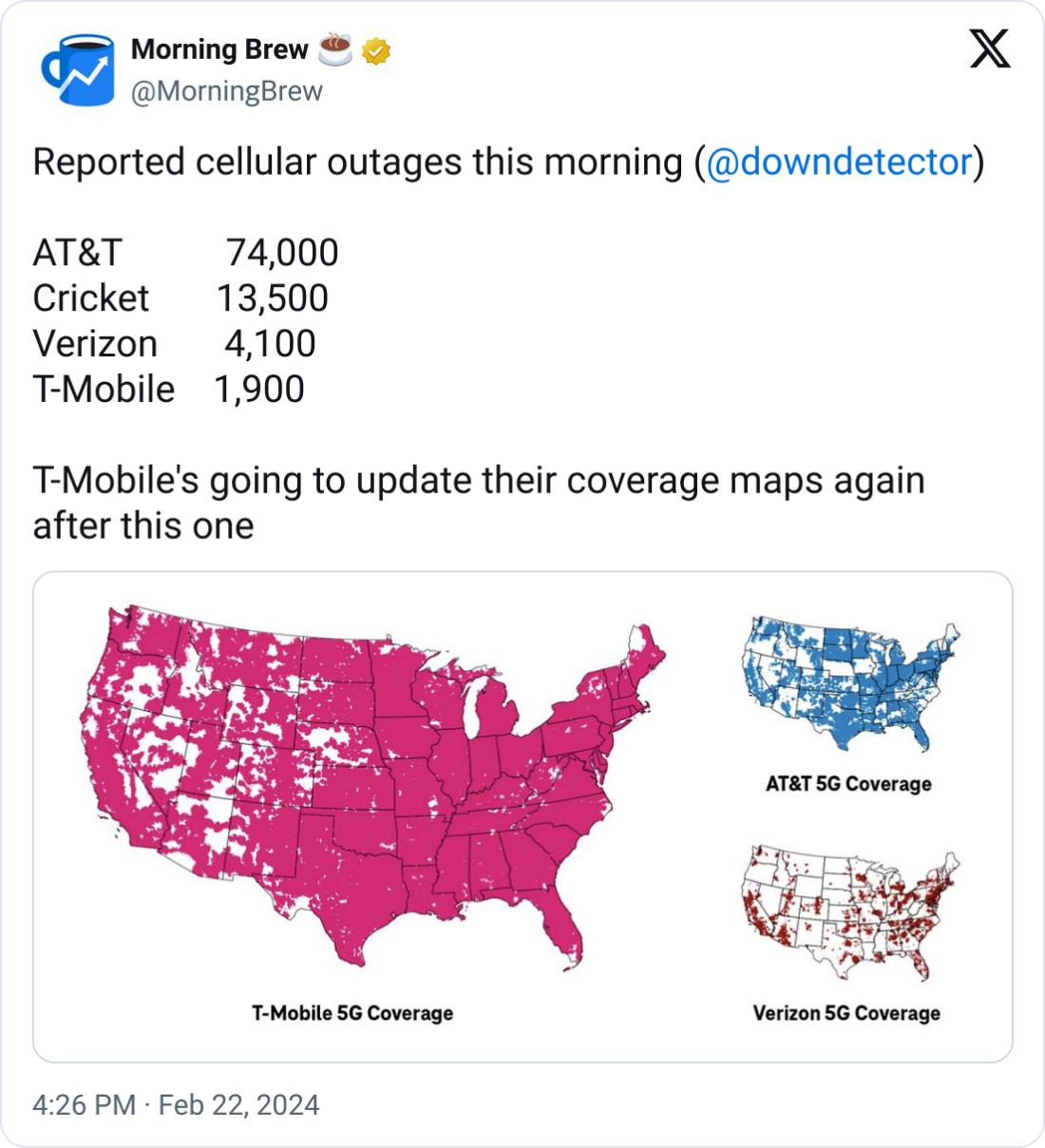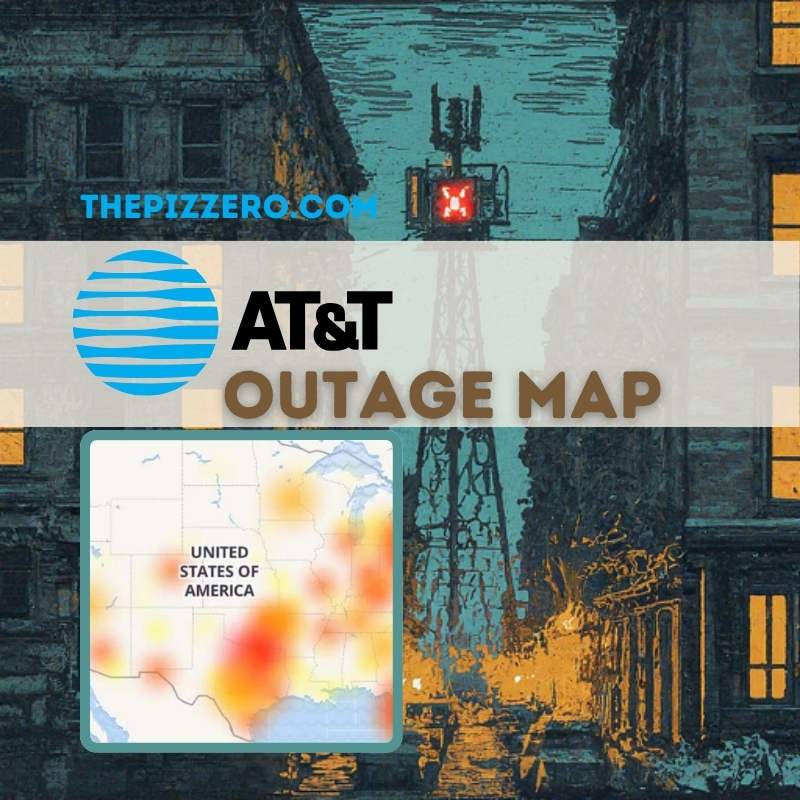AT&T Outage Chart: Your Ultimate Guide To Stay Connected
Imagine this—you're streaming your favorite Netflix show, and suddenly, BAM! The connection drops. Welcome to the world of AT&T outages. Whether you're a casual internet user or a business owner relying on AT&T's services, understanding the AT&T outage chart can be a lifesaver. In this article, we'll break down everything you need to know about AT&T outages, why they happen, and how to stay updated. Let's dive in, shall we?
AT&T is one of the biggest names in telecommunications, serving millions of customers across the United States. However, like any service provider, they're not immune to glitches and disruptions. The AT&T outage chart is your go-to resource when things go south. It’s like having a weather forecast, but instead of rain, it predicts internet downtime.
Now, before we get into the nitty-gritty, let's set the stage. AT&T outages can range from minor hiccups to major disruptions that affect entire regions. Understanding how the outage chart works and what causes these disruptions can help you prepare and minimize the chaos. So, grab your favorite drink, and let’s unravel the mystery of AT&T outages together.
Read also:Marisa Tomeis Journey In Hollywood A Life Dedicated To Work
What is an AT&T Outage Chart?
Let’s start with the basics. An AT&T outage chart is essentially a real-time map or table that tracks service interruptions across AT&T’s network. Think of it as a dashboard that shows where the problems are and how widespread they are. It’s a tool designed to keep customers informed about service disruptions, whether it’s due to technical issues, weather events, or other unforeseen circumstances.
For instance, if you're in Dallas and your internet goes out, the outage chart will tell you if it's just your neighborhood or the entire city that's affected. It’s like a treasure map for troubleshooting, but instead of gold, you're looking for stable internet.
Why is the Outage Chart Important?
The AT&T outage chart isn’t just a fancy map; it’s a critical resource for both customers and the company. For customers, it helps them understand the scope of the issue and whether it’s worth calling customer support. For AT&T, it’s a diagnostic tool that helps them pinpoint and resolve issues faster.
Here’s the kicker: the chart isn’t just for outages. It also tracks maintenance schedules, which means you can plan your activities around potential downtime. If you’re streaming a movie or working from home, knowing when AT&T is doing maintenance can save you a lot of frustration.
Common Causes of AT&T Outages
AT&T outages don’t just happen out of the blue. There are several factors that can lead to service disruptions. Let’s break them down:
- Weather Conditions: Natural disasters like hurricanes, thunderstorms, and heavy snow can wreak havoc on AT&T’s infrastructure. Trees falling on power lines or high winds damaging cell towers are common culprits.
- Technical Issues: Sometimes, the problem lies within AT&T’s network itself. Software glitches, hardware failures, or routing errors can all cause outages.
- Third-Party Problems: Believe it or not, other companies can impact AT&T’s services. For example, if a fiber-optic cable is accidentally cut during construction, it can affect AT&T’s network.
- Overload: During peak usage times, such as holidays or major events, the network can become overwhelmed, leading to slower speeds or complete outages.
Understanding these causes can help you anticipate and prepare for potential disruptions. For example, if a big storm is coming, you might want to download some offline content just in case.
Read also:Demi Moore The Red Carpet Queen Whos Just As Stunning In A Bikini
How to Check the AT&T Outage Chart
Checking the AT&T outage chart is easier than you think. Here’s how you can do it:
- Head over to AT&T’s official website or download their app.
- Look for the "Outage Map" or "Service Status" section. It’s usually prominently displayed.
- Enter your zip code or location to see if there are any reported outages in your area.
Alternatively, you can use third-party tools like Downdetector or Twitter to stay updated. These platforms aggregate data from multiple sources, giving you a broader view of the situation.
Tips for Using the Outage Chart Effectively
Now that you know how to access the outage chart, here are a few tips to make the most of it:
- Set Alerts: Most outage maps allow you to set up notifications for your area. This way, you’ll be the first to know if there’s a problem.
- Check Regularly: Outages can happen at any time, so it’s a good idea to check the chart periodically, especially during severe weather.
- Compare Sources: If AT&T’s chart doesn’t show an outage but you’re still experiencing issues, check other sources like Downdetector to confirm.
By staying informed, you can avoid unnecessary frustration and plan accordingly.
Understanding the AT&T Outage Map
The AT&T outage map is a visual representation of the outage chart. It uses colors and symbols to indicate the severity and location of disruptions. Here’s how to read it:
- Red Markers: These indicate major outages affecting large areas.
- Yellow Markers: These signify minor outages or localized issues.
- Green Markers: These show areas where service is fully operational.
Additionally, the map often includes details like the estimated time of resolution and the number of affected customers. This information can help you gauge the impact of the outage and plan your day accordingly.
How Accurate is the Outage Map?
While the AT&T outage map is generally reliable, it’s not perfect. Sometimes, outages might not be reported immediately, or the severity might be underestimated. That’s why it’s always a good idea to cross-check with other sources. If you’re experiencing an issue that’s not showing up on the map, don’t hesitate to reach out to AT&T support.
Steps to Take During an AT&T Outage
So, the worst has happened—your AT&T service is down. What do you do? Here’s a step-by-step guide:
- Check the Outage Chart: Confirm that the issue is widespread and not just a problem with your device.
- Restart Your Equipment: Sometimes, a simple reboot can fix the issue. Turn off your router and modem, wait a few minutes, and turn them back on.
- Call Customer Support: If the outage chart confirms a problem, call AT&T support for updates. Be prepared for potentially long wait times during major outages.
- Explore Backup Options: If you have a backup internet provider or a mobile hotspot, now’s the time to use it.
Remember, staying calm and informed is key. Panicking won’t fix the problem, but taking these steps can help you minimize the impact.
Preventing Future AT&T Outages
While you can’t completely prevent AT&T outages, there are steps you can take to reduce the likelihood and impact:
- Regular Maintenance: Ensure your equipment is in good working condition. Dust can clog vents, and old routers may struggle to keep up with modern demands.
- Backup Plans: Consider subscribing to a secondary internet provider or investing in a reliable mobile hotspot for emergencies.
- Stay Informed: Keep an eye on weather forecasts and AT&T’s maintenance schedule to anticipate potential disruptions.
By taking proactive measures, you can ensure that your connection stays as stable as possible.
What to Do If AT&T Outages Become Frequent
If you find yourself dealing with frequent AT&T outages, it might be time to escalate the issue. Here’s what you can do:
- Contact Customer Support: Provide detailed information about the outages and ask for a resolution plan.
- Consider Upgrading: Sometimes, upgrading your plan or equipment can help improve stability.
- Explore Alternatives: If the problem persists, it might be worth exploring other service providers in your area.
Remember, your internet service is crucial, and you deserve reliable connectivity.
Data and Statistics on AT&T Outages
According to recent studies, AT&T experiences an average of **50-70 outages per month** across the United States. While most of these are minor and resolved quickly, some can last for hours or even days. In 2022 alone, AT&T reported over **800 major outages**, affecting millions of customers.
Interestingly, weather-related outages account for approximately **30%** of all disruptions, while technical issues make up another **25%**. The remaining outages are caused by a combination of third-party problems and network overload.
These statistics highlight the importance of staying informed and prepared. By understanding the patterns and causes of outages, you can better anticipate and mitigate their impact.
Key Takeaways from the Data
Here are the key points to remember from the data:
- AT&T experiences a significant number of outages each month, but most are resolved quickly.
- Weather and technical issues are the leading causes of disruptions.
- Staying informed and having a backup plan can significantly reduce the impact of outages.
By keeping these points in mind, you can better navigate the world of AT&T outages.
Conclusion: Stay Connected, Stay Informed
AT&T outages can be frustrating, but they don’t have to derail your day. By understanding the AT&T outage chart and taking proactive steps, you can minimize the impact of disruptions. Remember, the key is to stay informed and prepared.
So, the next time your internet goes out, don’t panic. Check the outage chart, follow the steps we’ve outlined, and keep calm. And don’t forget to share this article with your friends and family so they can stay connected too. Together, we can weather the storm of AT&T outages and keep our digital lives running smoothly.
Call to Action: If you found this article helpful, leave a comment below and share it with your network. Let’s spread the word about staying connected in an ever-changing digital world!
Table of Contents
Article Recommendations


